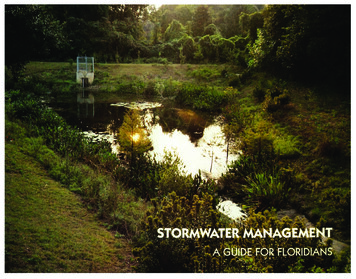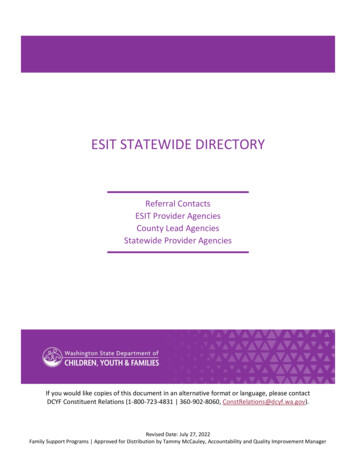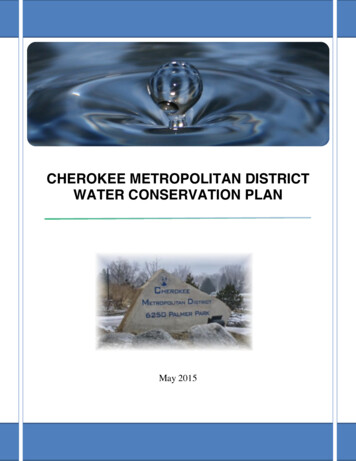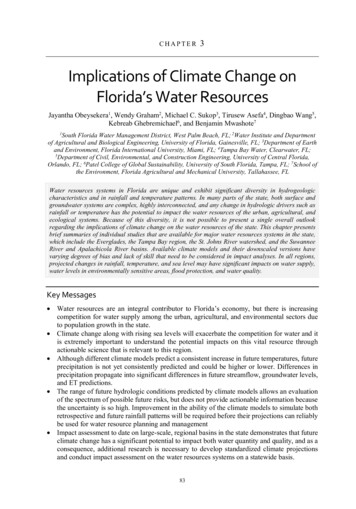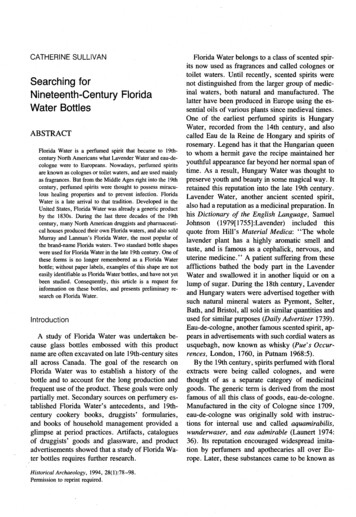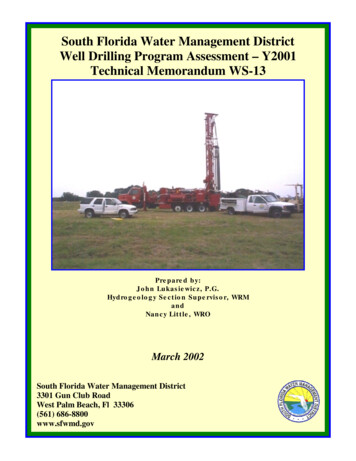
Transcription
South Florida Water Management DistrictWell Drilling Program Assessment – Y2001Technical Memorandum WS-13Prepared by:John Lukasiewicz, P.G.Hydrogeology Section Supervisor, WRMandNancy Little, WROMarch 2002South Florida Water Management District3301 Gun Club RoadWest Palm Beach, Fl 33306(561) 686-8800www.sfwmd.gov
Well Drilling Program AssessmentExecutive SummaryEXECUTIVE SUMMARYThis document was developed at the request of Mr. Joe Taylor (then Deputy Executive Director,Water Resources Operations Business Group). The request was conveyed in a staff meeting inSeptember 2000 to the authors when they were asked to assess the drilling program to determinewhether or not it is a “District core competency.” This document provides a summary of theprimary considerations reviewed to comply with that request. In addition, it includes staff’sassessment of the District’s drilling program and efficiency, examines short and long termdrilling plans and projections, and provides specific recommendations and alternatives for thefuture operation of the District’s drilling program.The District’s well drilling program began in 1976 and its performance is reviewed periodically.The last review was completed in 1996. Records of the program’s performance between FY97and FY98 were not maintained primarily due to changes in the organization during that time.Therefore, this report considers work performed only from FY99 and FY00. Past reviews notedthat the emphasis of the District drilling business was on data collected during the drillingoperation; while the emphasis of a private contractor, who must show a profit, was typically onspeed (maximum footage drilled per day). However, over the past five to seven years, Districthydrogeologists have had much success using contracted services to collect data while drillingboth shallow and deep wells.Up until October 2001, the drilling program was managed in the Electronic Support and DataAcquisition (ESDA) Department, under the Water Resource Operations (WRO) Resource Group,Technical Services Division. In October 2001, the drilling program was transferred to theHydrogeology Section in the Water Supply Department, under the Water ResourcesManagement (WRM) Resource Group. Three full-time drilling associates are in the program.Capital equipment consists of seven vehicles, including two drill rigs, and various types ofsupport equipment. In addition to drilling and constructing new wells, another importantfunction the District’s drilling program serves is in maintaining, repairing, and plugging existingDistrict monitor wells. The District maintains over 500 monitor wells, many of which areartesian (naturally flowing wells).Two major in-house drilling projects were accomplished in the two-year period between FY99and FY00. During that period, multiple shallow 2” diameter wells and one deep 12” diameterFloridan aquifer well were constructed. In-house costs to construct the shallow 2” diameterwells averaged 54 per cased foot, whereas contractor costs were estimated at 30 per casedfoot. In-house costs were approximately 80% higher than contract services for the two shallowwell projects. Deeper well construction costs for in-house drilling versus contractor were 234and 163 per foot, respectively, approximately 44% higher to do the work in-house.Other factors considered in evaluating whether this drilling program is a District “corecompetency” were broken out into pro’s and con’s as follows:PRO’s - Reasons TO Continue In-House Drilling Operations: Avoid financial loss on capital equipment;Increased flexibility provided to the District’s Project Managers;ES-1
Well Drilling Program Assessment Executive SummaryDistrict gains flexibility, positive image in emergency situations, (i.e. droughtmanagement monitoring);Reduction in project manager’s time spent on contracting out services;Backlog of available/pending drilling projects exists;Opportunities to enhance specialized “niche” drilling services exist; andThree District Associates are already qualified and trained to drill.CONS- Reasons NOT TO Continue In-House Drilling Operations: District procurement delays;District budget process impedes ability to optimize program’s efficiency;Drill crew limited to a 40-hour work-week;Program efficiency limited because of its small size and scale;Types of drilling methods and capabilities are limited;Current organizational structure inadequate. If a dedicated field supervisor cannot be addedto this operation, it should be discontinued;Politics biases judgement and ultimately drilling operations performance; andThe future of District drilling has shifted toward deeper ASR wells, outside the capabilitiesof the current equipment and drill crew.Based on our evaluation, we have concluded that the drilling business is not a District “corecompetency.” The authors recommend that the District ramp down and ultimately discontinueits drilling program if it cannot improve its efficiency and cost effectiveness. Complete recordsof the program should be kept in the future to make this assessment possible. A reassessment ofthe program should be made prior to the FY04 budget process and used as a stop/go decision toolby management.Program termination can be done abruptly (sell or auction all drilling equipment andimmediately re-direct staff to other work areas) or in phases. The authors recommend phasingthe program out over time as this would cause the least disruption. Steps would include thefollowing:1. Sell the Schramm rig;2. Complete the backlog of drilling projects that can feasibly be done with the mobilerig;3. Continue to use the District drill crew to maintain the District’s extensive monitorwell network and install new ones in select areas;4. Shift the activities of the drilling staff to ongoing hydrologic/hydrogeologic supportactivities in ESDA;5. Drilling staff to outsource well rehabilitation projects or re-train.ES-2
Well Drilling Program AssessmentTable of ContentsTABLE OF CONTENTSExecutive Summary . ES-1Background . 1Purpose and Scope . 1Previous Drilling Program Performance Reports. 1Organization, History, and Function of Drilling Program . 2Current Drilling Program Equipment and Capabilities. 3Inventory . 3Mobile Rig. 3Schramm Rig. 4Business Case Cost Analysis . 5In-House Drilling Operations – Pro’s and Con’s . 9Pro’s – Reasons to Continue In-House Drilling Operations . 9Con’s – Reasons Not to Continue In-House Drilling Operations . 10Conclusions and Recommendations. 15References . 17List of Tables:Table 1 Mobile Drill Rig Capabilities. 3Table 2 Schramm Drill Rig Capabilities . 4Table 3 FY99 and FY00 Drill Projects, Cost Comparison BetweenIn-House vs. Contracted. 6Table 4 FY99 and FY00 Miscellaneous Well Repair andWell Abandonment Projects. 7Table 5 Annual Budgets – In-House Drilling Program. 7Appendices:Appendix A-1 In-House Cost Estimate for Lake Toho Drilling. A-1Appendix A-2 District In-House Cost vs. Contractor Cost –2” Shallow Monitor Wells. A-2Appendix A-3 In-House Cost Estimate for LWC Water Shortage Drilling . A-3Appendix A-4 In-House Cost Estimate for Crew Land Drilling . A-4Appendix A-5 Cost Estimate for Ambient Well Repair – District Drill Crew . A-5Appendix A-6 Cost Estimate for Well Abandonment, KRR Pool C –District Drill Crew. A-6Appendix B-1 Cost Estimate for C-31 Drilling – District Drill Crew . B-1Appendix B-2 Drilling Rig and Associated Equipment Costs. B-2Appendix B-3 Contract Services Cost Estimates for St. Cloud FASDrilling Project. B-3Appendix C-1 Cost Analysis for Kissimmee Basin Drilling Project –Using Contractual Services . C-1Appendix C-2 Cost Analysis for Kissimmee Basin Drilling Project –Using District Drill Crew . C-2Appendix D Backlog of Drilling Projections by Region for In-HouseDrilling Operations. D-1i
Well Drilling Program AssessmentTable of Contentsii
Well Drilling Program AssessmentBackgroundBACKGROUNDPurpose and ScopeThis document was developed at the request of Mr. Joe Taylor (then Deputy Executive Director,Water Resources Operations Resource Group). The request was conveyed in a staff meeting onSeptember 2000 to the authors when they were asked to assess the drilling program to determinewhether or not it is a “District core competency.” A core competency is something only theDistrict can do well (better than the private sector). This document provides a summary of theprimary considerations reviewed to comply with that request. In addition, this documentincludes staff’s assessment of the District’s drilling program and efficiency, examines short andlong term future drilling work projections, and provides specific recommendations andalternatives for the future operation of the drilling program.Previous Drilling Program Performance ReportsThe performance of the District’s well drilling program is reviewed periodically. The programwas last reviewed in 1996. Previous reviews and business case documents were written in 1991and 1993. These included an extensive report written by the Budget Division. The final analysisof each of these reports has typically been to continue the program and follow-up with periodicreview. Cost analyses from previous reviews were based on several criteria including the type ofdrilling work performed for the time period of the review, the actual workload for Districtdrilling rigs and crews, and the method of evaluating cost. In some instances the costs wereshown to be more favorable using District staff and equipment. In other cases, contracted workefforts were shown to be more cost effective.Historically, it appears that the decision of whether or not to continue the District’s well drillingprogram using in-house resources has been difficult to evaluate. A statement from the BudgetDivision’s Well Drilling Final Report – Cost Analysis/Evaluation of the District’s Well DrillingProgram (October 1992), best describes this dilemma. “Besides costs, other factors should beconsidered before reaching a conclusion the intangible benefits associated with maintaining anin-house program, any unusual circumstances which may have affected the program’s costeffectiveness, and the projected level of future drilling activity.”Previous analyses of the District’s drilling services versus drilling by private contractors havereflected differences in costs based on the depth, diameter, and drilling method used. It wasconcluded that since well drilling for the purpose of scientific monitoring is not an exact science,unknown costs could occur in time and materials. There is potential for lost fluid circulation inhighly porous zones, which in turn can cause hole collapse around the drill rod. This canpermanently seal the rod in the hole. Lost drill rod is a costly risk. Since much of the drillingactivities take place in areas where little or no geologic information exists, that risk is relativelyhigh. To offset this, private contractors must include a risk factor in their costs to increase theprobability of making a profit on the job. This risk factor takes into account unforeseensituations that may occur during the drilling operation. Past reports noted that the emphasis ofthe District drilling business was on data collection during the drilling operation while theemphasis of a private contractor, who must show a profit, was typically on speed (maximumfootage drilled per day). However, over the past five to seven years, very successful datacollection and overall results have been realized using contracted drilling services for bothshallow and deep wells.1
Well Drilling Program AssessmentBackgroundOrganization, History, and Function of Drilling ProgramThe District initiated the well drilling program in 1976. Before October 2001, it was managed inthe Electronic Support and Data Acquisition Department (ESDA), under the Water ResourceOperations Resource Group, Technical Support Division. In October 2001, it was transferred tothe Water Supply Department under the Water Resources Management Resource Group. Threeregular, full time drilling associates staff the drilling crew. These staff members include oneSpecialist Drilling Associate, one Senior Drilling Associate, and one Staff Drilling Associate.The primary function of this drilling crew has been to drill water wells constructed primarily fordata acquisition. The lithologic, geophysical, hydraulic, and water quality data collected fromthese wells are used in the development of three dimensional ground water flow models thatdirectly contributes to the District’s strategic water supply planning and water quality initiatives.Data collected during construction, and then subsequently during long term monitoring of thesewells, provides information used for determining the occurrence and distribution of ground waterresources, availability of these resources, and ground water/surface water interactions.In addition to drilling and constructing new wells, another important function the District’sdrilling program includes maintaining and repairing existing monitor wells. There are over 500existing District wells to maintain. The drill crew also responds to emergency calls wherevalved, naturally flowing wells have been hit by maintenance crews and requires quick repair.This monitoring supports development and implementation of the District’s Lower East Coast(LEC), Lower West Coast (LWC), Upper East Coast (UEC), and Kissimmee Basin WaterSupply Plans, the Florida Department of Environmental Protection (FDEP)/District AmbientGroundwater Quality Program, and the United States Geological Survey (USGS)/Districtcooperative agreement contract network of monitor wells.2
Well Drilling Program AssessmentCurrent Drill Rig and Equip. CapabilitiesCURRENT DRILLING PROGRAM EQUIPMENTAND CAPABILITIESInventoryThe following equipment is part of the drilling program: V1842 Schramm T-685W Rotadrill (sold in Summer of 2001),V1200 Mobile Drill B-80V1333 Transport Truck (rig tender)V1389 Transport Truck (rig tender)V1841 Utility Truck, 4x4 (service truck)V2079 Backhoe/V1946 TrailerV1054 Utility Truck (outfitted with draw works for camera/video logging)Additional support equipment includes various sizes of drill rods and bits, two compressors,various pumps, and miscellaneous tools-of-the-trade such as: drilling elevators, well casing,drilling mud, de-sander, etc.The two drill rigs (Schramm-T-685W Rotadrill and Mobile Drill B-80) have differentcapabilities. Table 1 and 2 lists the current capabilities of the equipment in terms of drillingtechniques, casing diameters, and total depths attainable.Mobile RigThe Mobile Drill B-80 (V-1200) is equipped to drill shallow (10 to 200’ below land surface{bls}), dual tube (a coring method) holes. It can also be switched to mud rotary drilling asneeded to drill deeper holes (up to 500’ bls), and to install small casing diameter (2 to 4 inches)PVC wells. It can also be used to drill hollow-stem auger holes (12” diameter) up to 30’ bls.Table 1: Mobile Drill Rig Capabilities.DrillingTechniqueDual tubeMud rotaryAugerCasing Diameter InstallCapabilitiesDrill 6” diameter hole to set 2”diameter casing (flush jointsteel, or PVC/FRP)Drill 6” diameter hole to set 2”diameter casingDepth Capabilities (feet bls)Up to 200’ w/existing drill pipe – capability400’ w/purchase of additional drilling pipe.Up to 500’ unless hit rock, or lose circulation(could typically hit rock, or lose circulationfrom 200’ – 500’ bls)Up to 500’ unless hit rock, or lose circulationDrill 6” diameter hole to set 4”diameter casingDrill 12” diameter hole to set8” diameter casingDrill 12” diameter hole to set2” diameter casingDrill 12” diameter hole to set4” diameter casingIf no surface casing is needed, up to 200’unless lose circulation30’30’3
Well Drilling Program AssessmentCurrent Drill Rig and Equip. CapabilitiesSchramm RigThe Schramm T-685W Rotadrill Rig has the capability of drilling deeper (up to 2100’ achieved),8” diameter pilot holes using reverse air. The top-head is not outfitted to perform dual tubedrilling and would need to be changed for this capability. The Schramm rig is limited by thediameter casing it can set primarily because it has a maximum winch (lift) capacity of 6,200pounds. Therefore, the use of larger diameter, heavier steel casings is limited. Additionally, forlarger diameter holes, 12” – 16”, there are rig limitations related to the discharge configuration ofthe top-head drive which is less than desirable. The drilling crew has encountered problems withmaterials becoming plugged during drilling resulting in lengthy drilling times in certainconditions and depths.Table 2: Schramm Drill Rig Capabilities.DrillingTechniqueMud rotaryReverse airCasing DiameterDepth and CommentsDrill 6” diameter hole to set 2”diameter casingUp to 500’ unless hit rock, or lose circulation(could typically hit rock or lose circulation from200’ – 500’)Up to 500’ unless hit rock, or lose circulation(casing limit for 4” steel is approx. 550’)Up to 500’, limited to lost circulation (casinglimit for 8” steel is approx. 210’)Up to 500’, limited to lost circulation (casinglimit for 12” steel is approx. 125’)Depth of 2100’ achieved – drill rod available to2300’ (casing limit for 2” steel is approx.1650’)2100’ – 2300’ (casing limit for 4” steel isapprox. 550’)Drill 6” diameter hole to set 4”diameter casingDrill 12” diameter hole to set8” diameter casingDrill 16” diameter hole to set12” diameter casingDrill 6” diameter hole to set 2”diameter casingDrill 8” diameter hole to set 4”diameter casing (would set12” surface casing first)Drill 12” diameter hole to set8” diameter casingDrill 16” diameter hole to set12” diameter casing* (wouldset 18” surface casing first)Casing limit for 8” PVC is approx. 1170’Casing limit for 12” PVC is approx. 623’Casing limit for 12” steel is approx. 125’(would need stabilizer and bit – not ininventory)*Note: To set 18” surface casing, a 24” hole needs to be drilled. A large diameter stabilizer isneeded for this, which cannot easily fit in the drill floor (table) opening. To make it fit requiresmuch effort and time.4
Well Drilling Program AssessmentBusiness Case Cost AnalysisBUSINESS CASE COST ANALYSISAn attempt was made to obtain records related to drilling activities over the past five years.However, records were not maintained between FY97-FY98 primarily as a result of severalDistrict organizational changes over that period, whereby multiple changes in the supervisoryresponsibilities of the program took place. The monthly and quarterly drilling program reportsrecorded up to and including FY96 were used in the previously referenced drilling programreport (1996). Therefore, a complete report of program accountability over the past five yearswas not possible. It is strongly recommended that detailed records of the program’s performancebe required in the future.Table 3 lists drilling projects completed in FY99 and FY00 along with estimated costcomparisons between in-house and contracted services. The in-house cost estimates andassumptions are listed in Appendices A and B. Contractor costs were estimated using similarwork tasks taken from the District’s General Services Drilling Contracts C-10900, C-10991, C10992, C-10993, also managed in ESDA. Two in-house drilling projects were accomplished inthe two-year period between FY99 and FY00. The first involved constructing multiple, shallow2” diameter wells. The second involved constructing a deep (2,100’ bls), larger diameter (12”PVC) well at the C-31 site near St. Cloud, Osceola County. In-house costs per casing foot toconstruct the shallow 2” wells were 62 and 47 for the Lake Toho and LWC projects,respectively. This compared to estimated contract costs of 30 per cased foot. In-house costswere between 56% to 106% higher for the two shallow well projects, respectively. A summaryof those cost estimates are provided in Appendices A-1 through A-3. The drill rig used forthese shallow wells was V-1200 (the Mobile rig).Costs to drill the deeper well at St. Cloud with the Schramm rig were also higher than contractservices. Due to the limitations of this rig, the assignment took much longer than originallyanticipated. In fact, the well was never actually completed as will be discussed later in the report.Remaining work to complete the job is currently being outsourced to a local contractor. Costs forin-house drilling on the St. Cloud site versus contract costs were 234 and 163 per foot, or 44%higher in-house costs. In-house cost estimates are summarized in Appendix B-1. Furtherdiscussion on this Schramm rig is included later in this report.All in-house cost estimates consider the front-end costs of capital equipment amortized over 10years. The basis for the 10 years came from the District’s Fleet Replacement Plan (2001) and isthe life-span given for District’s drill rigs. Front-end costs include the annual lease (to purchase)payments on V-1842, materials and supplies, and an overhead factor as shown in Appendix B-1.Estimated contract costs calculated for equivalent work tasks are given in Appendix B-2. Aspreviously discussed, the cost comparisons provided in Table 3 demonstrate that in-house costswere not competitive with contract services for all classes of wells during this time period(FY99, FY00).The Schramm rig is not designed for installing long, heavy strings of steel casing. Rather, PVCcasing must be used. This is a major limitation as we found out at the C-31 site. Here, thebottom 30 feet of the 12” diameter PVC casing was shattered after installation while airdeveloping the well. The damaged casing was not repairable with District equipment. Repairsand well completion were subsequently outsourced to a drilling contractor. That work is still5
Well Drilling Program AssessmentBusiness Case Cost Analysispending as of this writing. Costs will probably exceed 100,000 to outsource completion of thewell. Steel casing is a necessity in deep well construction as was clearly demonstrated here.Based on our drill crew’s experience with the Schramm rig over the last two years, a moreoptimistic cost projection was done for a pending project in the Kissimmee Basin and ispresented in Appendix C-2 along with the assumptions used. The project consists of drillingshallow, intermediate, and Floridan wells. Although more competitive than the C-31 site, theDistrict cost to do business with the Schramm rig here still exceeds a predicted contract cost by32% (see Appendix C-1, and Appendix C-2). Twenty-two percent of that cost; however, is dueto the payment of the drill rig lease, a portion of which must be factored into each project. TheSchramm rig is on a 7-year, self-financed lease with a total cost of 560,000.Table 3: FY99 and FY00 Drill Projects, Cost Comparisons Between In-House VersusContracted.ProjectFY99 - Lake TohoDrawdown – monitorwells from 17-130’FY99 – Lower WestCoast WaterShortage – monitorwells from 18-298’C-31 Lower FloridanAquifer 2100’ testwellFY99 – drill to 380’to set casingFY00 – drill openhole to 2,100’FY99/00 LowerWest Coast WaterShortage – CREWLandRigDistrict TotalCost (labor &equip.)ContractorCostTotalDistrict vs.ContractorCosts( per foot)329’V1200 20,482(Append. A-1) 9,979 62/302”1,432’V1200 66,925(Append A-2) 42,960 47/30118” to 104’12” to 380’6” to 2100’2,100’V1842 492,550(Appendix B-1and B-2) 342,360*(AppendixB-3)42”168’V1200 6,150(Appendix A-4) 5,040# ofWellsCasingDiameterTotalFeetDrilled52”11 234/163 37/30* Cost to outsource completion of wellIn addition to constructing the wells listed in Table 3, the drill crew also repaired and pluggedexisting District monitor wells in FY99 and FY00. These activities are listed in Table 4. Costsfor these miscellaneous repair projects were estimated to amount to 33,700.6
Well Drilling Program AssessmentBusiness Case Cost AnalysisTable 4: FY99 and FY00 Miscellaneous Well Repair and Well Abandonment ProjectsFiscalYearFY99Cost perWell 2,000# ofWells3Total 6,000Well Repair- MiscFY00Well Repair – Ambient GW Network, (Appendix A-5) 74214 10,393FY00Well Repair – SFWMD & USGS General Groundwater Network 1,0003 3,000FY00Kissimmee River Restoration – Wells plugged, (Appendix A-6) 2,0437 14,300ProjectGrand Total: 33,693The annual operating budget for the District’s drilling program is summarized in Table 5. Theseannual totals include funds budgeted under all object codes in each annual budget from FY99through FY01. The drilling program was funded at a level of approximately 400,000 each ofthe last two fiscal years (FY00 and FY01) and just over 500,000 in FY99. Although budgeted,the actual amounts spent each year were probably somewhat less than these amounts since eachyear some funds remain unspent. However, overhead costs such as staff time in Fleet for vehiclemaintenance, upper management time, etc. are not captured here.Table 5: Annual Budgets – In-House Drilling ProgramObject Code51015210 - 59559956505654DescriptionRegular Salaries & WagesFringe BenefitsOther Contractual ServicesParts/Supply/Expns - OtherPhotographic SuppliesOffice SuppliesLumber & Wood ProductsMetal ProductsUniforms & Safety ShoesEquipment RentalCapital Lease Annual PaymentsTrainingTravelProfessional LicensesFreightAutomotive EquipmentFurniture and EquipmentTotalsFY99 140,561 48,086 45,000 94,184 0 0 1,000 486 1,000 0 84,861 100 5,463 125 0 71,000 16,952 508,8187FY00 103,703 36,478 45,500 111,540 0 0 0 0 1,230 0 84,861 0 21,800 150 1,250 0 0 406,512FY01 107,851 37,937 45,500 96,540 100 800 0 0 1,230 15,125 84,861 0 16,350 300 1,250 0 0 407,844
Well Drilling Program AssessmentBusiness Case Cost Analysis8
Well Drilling Program AssessmentIn-House Drilling OperationsIN-HOUSE DRILLING OPERATIONS – PRO’S AND CON’SPRO’s - Reasons TO Continue In-House Drilling Operations1. Avoid financial loss on capital equipment. The newer “Schramm” drill rig wasprocured in FY98 using a self-financed, lease/purchase funding arrangement. Underthe terms of the arrangement, lease payments will end in FY05. The Schramm drillrig purchase price was approximately 560,000. As of FY01, a balance of 327,000was owed to complete the purchase. Scheduled payments began in FY98 and willcontinue through FY05. Lease payments have been budgeted for fiscal year (FY01)through the “D” program in Water Supply. However, the “D” program managers areconcerned about the cost-effectiveness of the operations and are reconsideringfunding the entire program in future years. The Schramm rig sold at auction for 200,000 on September 2001.Other related support equipment include the older Mobile rig, as well as the otherassociated support vehicles and equipment. The current market value for theequipment has not been assessed.2. Avoid political ramifications of sustaining the loss described above. This topicaddresses questions of “Why are we in this situation today?” and “Why did Districtbuy this rig (Schramm) if operating it is not cost effective?” An explanation is offeredunder CON’s, number 1.3. Increased flexibility provided to the District’s Project Managers. Using Districtdrilling capabilities, the project manager of a drilling assignment has increasedflexibility and is not “locked into” a predefined scope of work. The project scope canbe modified without costly and time-consuming contract amendments that mightoccur if such changes were required of the drilling contractor. However, there is adrawback to this because the project manager at times can easily procrastinate and notscope out the project until the final hour.4. District gains flexibility, positive image in emergency situations, (i.e. droughtmanagement monitoring). When the District declares water shortage restrictions inareas impacted by drought conditions, there have been instances when installation ofnew wells are
Well Drilling Program Assessment Background 2 Organization, History, and Function of Drilling Program The District initiated the well drilling program in 1976. Before October 2001, it was managed in the Electronic Support and Data Acquisition Department (ESDA), under the Water Resource Operations Resource Group, Technical Support Division.



